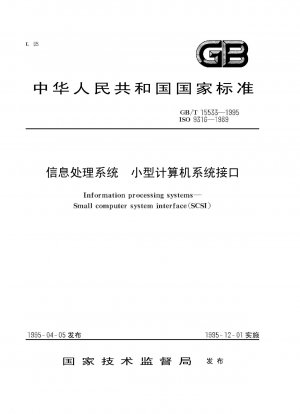GB/T 15533-1995
Information processing systems--Small computer system interface(SCSI) (English Version)
- Standard No.
- GB/T 15533-1995
- Language
- Chinese, Available in English version
- Release Date
- 1995
- Published By
- General Administration of Quality Supervision, Inspection and Quarantine of the People‘s Republic of China
- Latest
- GB/T 15533-1995
- Scope
- This standard provides the mechanical, electrical and functional requirements for the input and output buses of small computers and the commands of various types of peripheral devices commonly used in small computers. The small computer system interface (SCSI) described in this standard is a local input and output (I/O) bus with a data transfer rate of up to 4MB/s according to the selected implementation circuit. The main purpose of the interface is to enable the host computer to communicate with the Devices within a certain range are connected and used. Thus, various disk drives, CD drives, tape drives, printers, and even communications equipment can be connected to the host computer without requiring modifications to general system hardware or software. At the same time, non-common features and functions can be added through vendor-specific fields and codes. The interface uses logical addressing instead of physical addressing for all data blocks. For direct access devices, the number of data blocks can be determined by searching the logical components. The logical components can be consistent with some or all peripheral devices. When using differential drivers and receivers, the specified cable length should not be greater than 25m. When using a single-ended driver and receiver structure, the cable length should not exceed 6m, mainly for internal use. The interface protocol includes provisions for the connection of multi-boot devices (SCSI devices with the ability to start operations) and multi-target devices (SCSI devices with the ability to respond to operational requests). The selected distributed Zhongyanmang (that is, the bus contention logic) is set inside the SCSI structure. The priority system will control the interface to the SCSI device with the highest priority that wants to use the bus, and the time to complete the arbitration has nothing to do with the number of competing devices, and it can be completed within 10μs. Physical properties are described in Chapter 4. There are two electrical options: single-ended and differential. Single-ended and differential devices are electrically different and should not be mixed on the same bus. In addition, there are several options: shielded or unshielded connectors can be used, odd-even or not. Chapter 5 describes the logical characteristics of the interface. An arbitration selection specification allows multiple boot devices and parallel I/O operations, requiring all SCSI devices to be able to operate under the specified asynchronous transfer protocol. In addition, an optional synchronous transfer protocol is specified. Clause 5 also specifies the message protocol for interface control. In most cases, the messages do not appear directly to the host computer software. Only one message command completion (COM-MAND COMPLETE) is necessary, and the others are optional, that is, they are not required to be implemented. Note that some options (such as synchronous transfer) require certain messages to be implemented. The SCSI command structure is specified in Chapter 6, and commands are classified as mandatory (M), extended (E), optional (O) or vendor-specific (V). The SCSI device shall implement the necessary commands specified for the corresponding type of device, and may also execute other commands. Expanding SCSI devices should implement all expansion plus all necessary commands, and can also execute other commands. Extended SCSI devices contain commands that make it easy to write self-configuring software drivers that "discover" all the required attributes without prior knowledge of a peripheral's characteristics, such as storage capacity. Although the necessary commands for direct access devices use only a few smaller logical block address spaces (221 blocks), the extended commands for direct access devices also use very large logical address spaces (232 blocks). Clause 7 specifies commands with the same meaning for all types of equipment. Chapters 8 through 13 contain commands for direct access (such as disks), sequential access (such as tapes), printers, write-once-read-many (such as CD-ROMs), and read-only direct-access devices, respectively. In these chapters, the commands of each chapter are specific to this type of device, or they have interpretations, fields or characteristics specific to this type of device. For example, although the write command is used in several types of devices, it has different forms for each type, and the parameters and meanings are also different, so each type of device is specified separately. Chapter 14 describes the status bytes for all types of devices. Status is returned by the target device at the end of each command execution.
GB/T 15533-1995 history
- 1995 GB/T 15533-1995 Information processing systems--Small computer system interface(SCSI)
